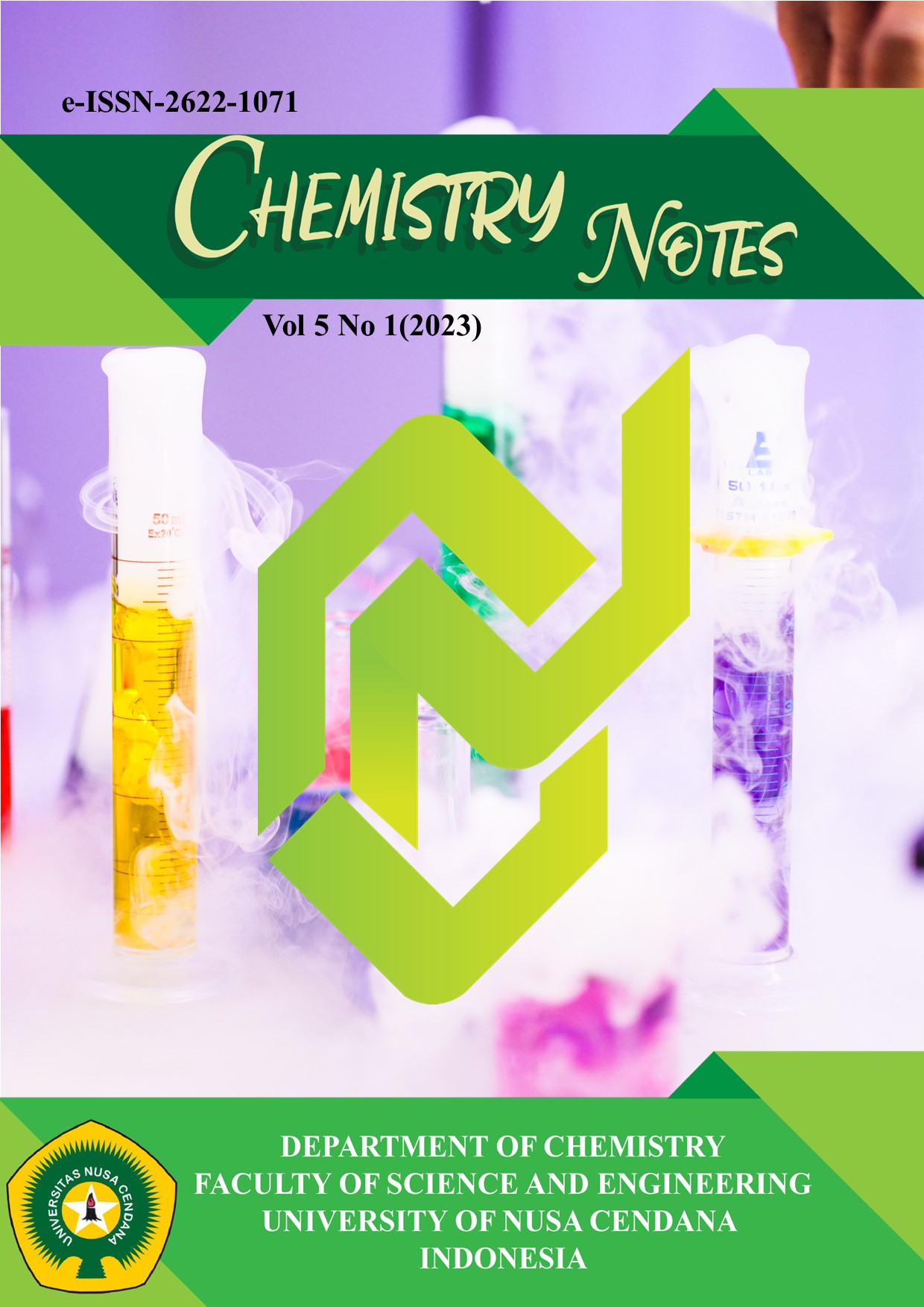USE OF SEQUENT ADSORPTION WITH ACTIVATED NATURAL ZEOLITE AND ACTIVATED CHARCOAL AS ADSORBENT TO IMPROVE THE QUALITY OF WASTE COOKING OIL
Abstract
Cooking oil which is exposed to high temperatures of up to 200 °C during the cooking process, leads to the formation of hazardous substances that are potentially dangerous to human health. However, people sometimes use the same cooking oil repeatedly without considering the negative effects that it causes. In this work, we investigated the use of two different types of adsorbent namely activated charcoal and activated zeolite sequentially to improve the quality of waste cooking oil (WCO) using the adsorption method. It was found that for 30 mL of WCO, the optimum dose of adsorbent was 7.5 g and the optimum contact time was 20 minutes. When these two types of adsorbent were applied sequentially for the purification of WCO at the optimum conditions, the result obtained indicated the lower value of the acid number, peroxide number, viscosity, and water content, compared to the WCO that treated only with a single type of adsorbent.
Downloads
References
2. Osseo, L.S., Caputo, G., Gracia, I. & Reverchon, E., 2007, Continuous Fractionation of Used Frying Oil by Supercritical CO2, Journal of the American Oil Chemists’ Society, Vol. 81(9), pp. 879-885.
3. Choe, E. & Min, D., 2007, Chemistry of Deep Fat Frying Oils, Journal of Food Science, Vol. 72(5), pp. R77-R86.
4. Ullah, Z., Bustam, M.A. & Man, Z., 2015, Biodiesel Production from Waste Cooking Oil by Acidic Ionic Liquid as A Catalyst, Renewable Energy Vol. 77, pp. 521-526.
5. Rincón, J., Martínez, F., Rodríguez, L. & Ancillo, V., 2011, Recovery of Triglycerides from Used Frying Oil by Extraction with Liquid and Supercritical Ethane, The Journal of Supercritical Fluids, 56(1), pp. 72- 79.
6. Wonglamom, J. & Rakariyatham, N., 2014, Recovery of Used Vegetable Frying Oil by Two Step Adsorbents, 26th Annual Meeting of The Thai Society for Biotechnology and International Conference, pp. 330-337.
7. Miyagi, A., Nabetani, H. & Subramanian, R., 2011, Purification of Crude Fatty Acids Using A PDMS-Based Composite Membrane, Separation and Purification Technology, 77(1), pp. 80-86, 2011.
8. Doula, M.K., 2006, Removal of Mn2+ ions from drinking water by using Clinoptilolite and a Clinoptilolite Fe oxide system, Water Research 40 (17), 3167–3176.
9. Tsitsishvili, G.V., Andronikashvili, T.G., Kiriov, G.N. dan Filosova, L.D., 1992. Natural Zeolites, Ellis Horwood, NewYork 1-14.
10. Patel, H., 2018, Charcoal as an adsorbent for textile wastewater treatment, Separation Science and Technology, 53(17), 2797-2812, DOI: 10.1080/01496395.2018.1473880
11. Ola, P.D., Djami, A.G. and Wogo, H. E., 2013, The Use of Activated Natural Zeolite as an Adsorbent on Removing of Rhodamine B from Aqueous Solution, J Applied Chem. Sci. Vol. 2 Issue 2; 252-258.
12. Juandi, D., 2015, Peningkatan Kualitas Minyak Jelantah Menggunakan Zeolit Alam dan Arang Tempurung Kelapa Secara Simultan, Skripsi Jurusan Kimia Fakultas Sains dan Teknik, Universitas Nusa Cendana, Kupang.
13. Nesimnasi, A.N., Ola, P. D., 2012, Pemanfaatan Zeolite Alam untuk Meningkatkan Kualitas Minyak Goreng Bekas, Jurnal MIPA Penelitian dan Pengembangan Vol. 12 No.

This work is licensed under a Creative Commons Attribution-NonCommercial-NoDerivatives 4.0 International License.
In order to publish in Chemistry Notes, authors are required to agree to the copyright permission stating that the authors give the publisher the right to reproduce, display or distribute the accepted manuscript. In this agreement the authors also automatically declare that the submitted manuscript is exempted from plagiarism issue and conflict of interest among the authors.

 Pius D. Ola(1*)
Pius D. Ola(1*)





